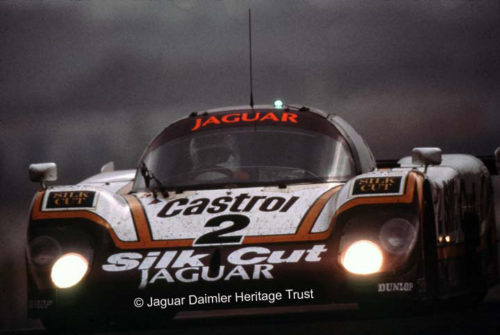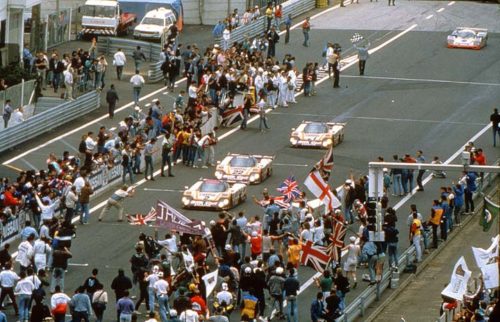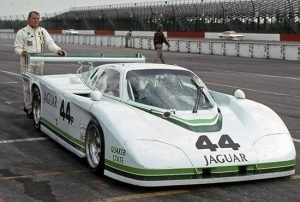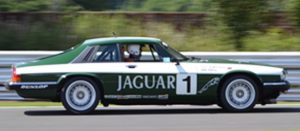1988 XJR-9 – Jaguar’s 6th Le Mans Win
Jaguar’s spiritual sporting home is Le Mans, the scene of many victories.
After their series of victories at Le Mans in the 1950s with the C and D types, Jaguar withdrew their works teams from the competition scene and concentrated on the business of manufacturing and selling cars. The 1956 Le Mans was won by an Ecurie Ecosse D type and it marked the end of official Jaguar involvement with Le Mans.
However, when John (now Sir John) Egan arrived at Jaguar he looked at the racing scene to help re-establish the Jaguar brand and increase sales. He was fortunate in having an ally in North America. In the United States, Bob Tullius, a long-time supporter of Jaguar cars on the competition circuit created Group 44 in collaboration with Mike Dale, Jaguar’s Chief Executive in North America. Tullius had many successes with Jaguar E-Types and XJ-S models in Group 44 and it was then a logical step to develop his own Jaguar model specifically under the International Motor Sports Association (IMSA).
John Egan was receptive to the idea and tacitly agreed to support the enterprise. Lee Dykstra designed the chassis to take the road-going six-litre Jaguar V12 engine and the whole was clothed in a sleek body. As the XJR-5 it raced for the first time in 1983 in the IMSA Grand Touring Prototype (GTP) category. Over the months, the XJR-5s gained six wins and fourteen second places. Tullius took two XJR-5s to Le Mans for 1984 where they showed promise during the early stages, but eventually both cars retired before the finish. In 1985 the two XJR-5s were back and this time one car – running on eleven cylinders – finished 13th.
Meanwhile in the UK, Tom Walkinshaw had achieved some competition success and, in 1981, approached Jaguar with a proposal to race the XJ-S.
Egan was receptive and two cars were supplied. Walkinshaw rewarded Jaguar with four outright wins in 1982 on the European Touring Car championships. For the 1983 season, Jaguar officially supported the Tom Walkinshaw Racing (TWR) team. The TWR cars were victorious and naturally attention was turned to the Le Mans 24-Hour Race.
Le Mans Specials
Engineers and designers from TWR and Jaguar worked together to design a car that would race at Le Mans and perhaps bring victory. Walkinshaw had an XJR-5 on loan for tests and as a possible entry for Le Mans, but decided that it was not ideal for his requirements and set about working on a specific TWR Le Mans car. This was designed by Tony Southgate and emerged as the XJR-6 and made its debut at Mosport in Canada in August 1985 to finish in third place. The car raced at Le Mans in 1986 and held second place for most of the race, but failed to finish. Walkinshaw had advised the Jaguar board that it would take three years for Jaguar to win at Le Mans.
For 1987, TWR had a new car, the XJR-8 with a 7-litre Jaguar V12 engine delivering 720 bhp. Three cars were entered for Le Mans, two retired and one finished fifth. The car had potential and was redesigned with two versions being prepared; one for IMSA and the other for the Worlds Sports Prototype Championship (WSPC). In January 1988, the TWR XJR-9 driven by John Nielsen, Martin Brundle and Price Cobb won their opening race at Daytona.

1988 Le Mans XJR-9
In June, five examples of a version developed for Le Mans – XJR-9LM – arrived at Le Mans for the non-stop 3,311 mile event. The five cars had two separate pit crews and the fourteen drivers were split into two teams: the European team overseen by Roger Silman consisted of: Car No. 1 Martin Brundle and John Nielsen; No. 2 Jan Lammers, Johnny Dumfries and Andy Wallace; No. 3 John Watson, Henri Pescarolo and Raul Boesel.
The IMSA team overseen by Tony Dowe comprised two cars: No. 21 Danny Sullivan, Davy Jones and Price Cobb and No. 22 Derek Daly, Kevin Cogan and Larry Perkins.
With five cars in the running, it was later estimated that one of them was stopping in the pits every ten minutes. This meant that the pit crew never had a real break during the race, but not one of them complained.
The pressure for Jaguar to succeed was extreme and a great deal was riding on the race. They had to break the stranglehold that Porsche had on the event, and with eleven assorted examples in the running that would be quite an achievement. During the practice laps, it seemed that Porsche had the edge and the works team took the three top spots with Jaguar in fourth; Martin Brundle set a time of 3 min 21.78 secs. Making their first official appearance at Le Mans since the disaster of 1955 was Mercedes-Benz; unfortunately, they had problems with the cars during the practice laps and race manager Max Welti was forced to withdraw the team.
At 15:00 hrs on 11 June, the Tricolour fell and 260,000 spectators watched as the cars made a rolling start to the race. The three works Porsche 962Cs were quick off the mark with the Jaguars in hot pursuit and by the end of lap one Hans Stuck (Porsche) was leading with Jan Lammers second. Further back was Martin Brundle whose car was handling poorly, after the rear anti-roll bar had been removed during his practice lap, to try and compensate for overheating tyres. However, on lap six Lammers took the lead with three Porsches hard on his heels. Brundle was in fifth place with John Watson vying for sixth place with the Porsche of Stanley Dickens. Tom Walkinshaw brought Watson in for his first refuelling stop, after just 35 minutes of racing. Watson handed over to Raul Boesel; the other Jaguars also came in to change drivers and refuel.
Johnny Dumfries was in the lead in XJR-9LM, No 2, with Hans Stuck immediately behind and another Porsche in third place. This arrangement went on until Dumfries stopped for fuel and left the trio of Porsches to take the three top positions, but when they stopped for fuel, he was back in the lead. Unfortunately, John Nielsen driving Jaguar No 1 spun at Indianapolis and lost time as he was winched out of the sand traps. The car was undamaged and restarted to take him back into the race in 15th place.
On the run up to the twelve-hour mark, the race lead was to change no fewer than 22 times between the Lammers Jaguar and the three factory Porsches. After four hours the lead was alternating rapidly between Jaguar and Porsche, but a small shunt between Lammers and a Porsche from the Brun Motorsport team put the Jaguar into the pits. Here the tail was repaired quickly, but it cost them over a minute in time and left the Porsche of Sarel van der Merwe in the lead. Andy Wallace took over the Lammers car and by 23:00hrs had made up the lost time to snap at the heels of the Porsche, now driven by Bob Wolleck.
At midnight, the transmission of the Watson/Pescarolo/Boesel XJR-9 No 3 failed and put it out of the race when Boesel was driving. None of the gears would connect and his was the first Jaguar out of the race. At the same time, the Lammers/Dumfries/Wallace XJR-9 had taken the lead being chased by the Stuck/ Bell Porsche and the Brundle/Nielsen Jaguar. Lying in third place for a time was car No. 21 but then it too suffered problems with its gearbox and slowed down in order to try and finish. Jaguar No 2 was leading the Porsche of Klaus Ludwig by 25 seconds and Martin Brundle was lying third. In fifth place was XJR-9 No 22. Meanwhile, Car No 21 had soldiered on and was in 24th place by 05:00 hrs, which included two stops to have the rear body changed to eliminate transmission vibration. Andy Wallace came into the pits and the Porsche took the lead, this then changed when the Porsche came in soon afterwards. Jan Lammers brought his XJR-9 in for an unscheduled pit stop at 06:35 hrs with a split windscreen. Walkinshaw himself pulled the glass out which was quickly replaced. Then the Porsche of Stuck/Bell pulled into the pits and left Jaguar out in front. Brundle and Nielsen had done wonders with their XJR-9, then disaster struck when a stone hit the radiator to cause water loss and overheating. Sadly, when fluid was added the cylinder head split and the car was out of the running.

1988 Le Mans XJR-9 Formation Finish
There was just six hours left and Jaguar No 2 was leading the Porsche of Stuck/Bell/Ludwig by 100 seconds. With two hours to go, Derek Bell pulled into the pits with fuel pump problems, his place in the car was taken by Klaus Ludwig who rapidly made up the lost time and closed in on the leading XJR-9LM. Both cars made fuel stops at different times and the gap increased and decreased, but the two Jaguars maintained first and fourth positions. As the clock ticked down and the 56th Le Mans drew to a close the Jaguar XJR-9LM No 2 crossed the finishing line 2 minutes and 36.85 seconds ahead of the Porsche. A Jaguar had won Le Mans again after a 31-year absence. Fourth place was taken by Jaguar No 22 and sixteenth place went to Jaguar No 21.
When it was apparent that the race was in the bag, with just four laps to go, Tom Walkinshaw sent a radio message to each of the three Jaguar drivers with instructions that they should assemble for a formation finish.
It was quite a sight to see the three Jaguar XJR-9LMs with Jan Lammers in the lead drive past the capacity crowd who enjoyed every minute and shared in the victory that was so richly deserved. Porsche took second, third, fifth and sixth places in a hard-fought race that was one of the most exciting Le Mans ever. Tom Walkinshaw had delivered what he had promised in 1986 and John Egan’s confidence in TWR was amply rewarded. The winning XJR-9 had completed 394 laps, covering 3,313.15 miles (5,330.86 kms) at a speed of 137.72 mph (221.59 km/hr).
Tom Walkinshaw later went on record saying the formation finish wasn’t just for publicity purposes “Jan radioed in with about three laps to go, he was starting to have trouble with some gear selection. The other cars were around, and that’s when I started radioing them to say right you know I’m going to try and get you behind Lammers and once you’re behind there, if he has a problem, you’re to push the damn thing home. And that’s what there were told to do….. There were there to do a job, should he run out drive on the last lap, there job was to push it there .”
Derek Bell was clearly delighted that Jaguar had won and was one of the first to congratulate John Egan and Tom Walkinshaw. Bell later recalled, “I had raced at Le Mans eighteen times by 1988 and won it five times, so although I would have liked a sixth win, it was clearly Jaguar’s turn to win. I was very pleased to see them back in such good form.”
After the win, Johnny Dumfries said, “It was a fantastic moment, so emotional with thousands and thousands of supporters. The atmosphere was really electric.” Andy Wallace said at the time: “To come to Le Mans for the first time and win was a dream come true. The team is tremendous, the very best there is and I was very proud to race and triumph with them.” Wallace had never driven a racing car at sustained speeds in excess of 200 mph before this Le Mans and he covered the Mulsanne straight at over 240 mph.
Jaguar celebrated the victory worldwide with its advertising and also with a series of public and corporate appearances of the winning cars and drivers. One of the most public showings was a parade of the three cars and the winning team of drivers through the streets of Coventry. The people of the City turned out to line the route and welcome the victorious Jaguar team.
Jaguar had taken the plunge and stayed the course, they had the courage and confidence to encourage Bob Tullius and Tom Walkinshaw in their separate ventures to restore Jaguar’s lost sporting lustre. That both men delivered is now a matter of history, but one should not forget the part played in this success by Mike Dale and Sir John Egan.
Le Mans 1988 Results
| Place | Drivers | Car | Laps |
| 1st | Jan Lammers Johnny Dumfries Andy Wallace |
Silk Cut Jaguar XJR-9LM | 394 3,313.15 miles 5,330.86 kms |
| 2nd | Hans-Joachim Stuck Derek Bell Klaus Ludwig |
Porsche 962C | 394 |
| 3rd | Stanley Dickens Frank Jelinski Louis Krages |
Porsche 962C | 385 |
| 4th | Derek Daly Larry Perkins Kevin Cogan |
Jaguar XJR-9LM | 383 |
| 5th | David Hobbs Didier Theys Franz Konrad |
Porsche 962C | 380 |
| 6th | Mario Andretti Michael Andretti John Andretti |
Porsche 962C | 375 |
| 16th | Danny Sullivan Davy Jones Price Cobb |
Jaguar XJR-9LM | 331 |
Jaguar XJR-9LM Specification
| Body | Group C sports racing; two-doors, nominal two-seats. |
| Weight | 1,874 lb (850 kg) WSPC 1,984 lb (900 kg) IMSA |
| Engine | Seven-litre Jaguar: 12 cylinders in 60 degree V – 750 bhp – WSPC spec. Six-litre V12 – 650 bhp – IMSA spec. One chain-driven overhead cam per bank. 2-valves per cylinder; aluminium cylinder head; cast iron block; 7-bearing crankshaft; water cooled. Lucas Micros engine management system. |
| Transmission | Rear wheel drive; clutch AP racing triple plate. Five-speed TWR/March manual gearbox. Transaxle final drive. |
| Chassis Details | Composite carbon fibre and Kevlar monocoque. Front suspension: wishbones, pushrods to spring/damper units mounted horizontally in the centre. Rear suspension: magnesium uprights, titanium coil springs and damper units mounted within wheel. Ventilated disc brakes front and rear. Rack and pinion power-assisted steering. |
| Fuel Capacity | 22 gal (100 ltr) WSPC 26 gal (120 ltr) IMSA |
| Tyres | Dunlop racing tyres. 17 in rims front, 19 in rims rear. |
| Dimensions | Wheelbase: 109.5 in (278 cms) Front track: 59 in (150 cm) Rear track: 59 in (150 cm) Length: 189 in (480 cm) Width: 79 in (200 cm) Height: 43 in (110 cm) |
Author: François Prins
© Text and Images – Jaguar Daimler Heritage Trust

